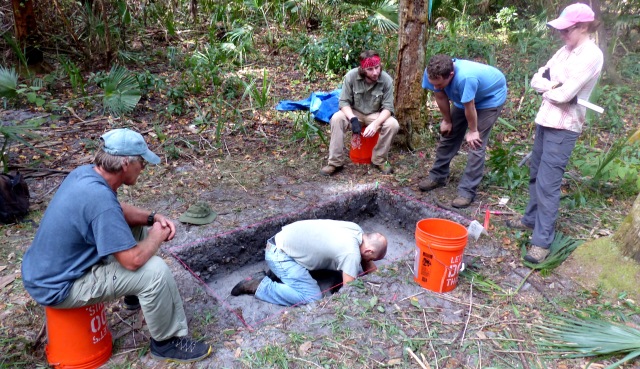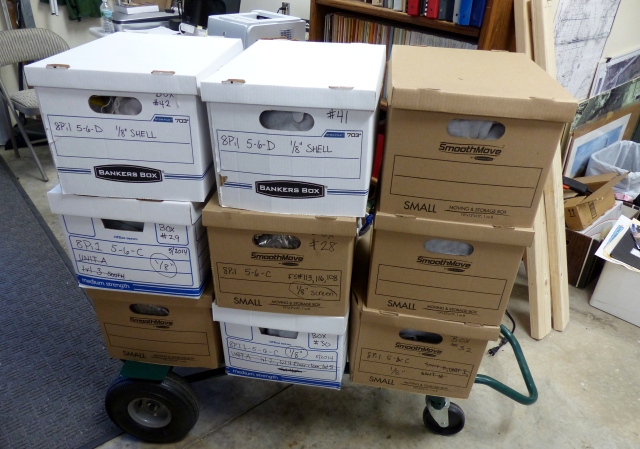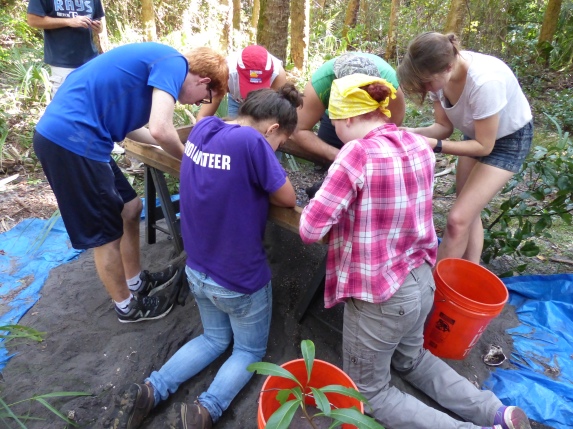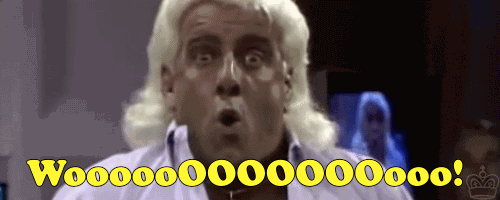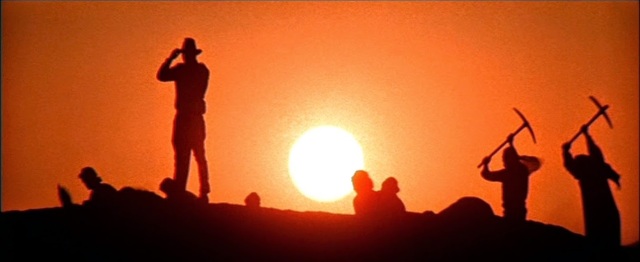This post spawns from a few recent experiences that have led me to consider the role of the professional archaeologist on social media platforms. We all recognize the power and potential of social media as a communicative device, especially as it relates to the communication and translation of scientific information for the general public. Whether a social media presence is meant to convey points of view or simply to report current news within a discipline or progress on particular field/lab projects, many of these platforms are situated to communicate anthropological/archaeological research to the public. I am specifically interested in exploring the presence of professional archaeologists on Facebook, especially in regards to many of the Facebook pages that have popped up in the past few years that are described as places for the sharing and discussion of archaeological/anthropological research. To illustrate, below are a few descriptions provided by some of these public Facebook pages:
“If you’re an archaeologist get yaself in here, post some pics and vids, share some stupid stories, birch about the heat, the rain, the mud, the flies, the public, the contract. Maybe tell us about an amazing or not so amazing dig you’ve been on, whatever grabs ya. Feel free to post a link to something interesting but please leave with the link a quick synopsis of what it relates to, why you think it’s interesting, that sort of thing. Of late we’ve been getting a fair few airy fairy links and discussions about magical mystical fairy lands and we’re pretty chock a block full of all that for now. So in future if you post something along those lines, it will be removed, if you are a repeat offender we’ll then remove you. Enjoy the group, we have some great discussions and links and pics and fun in here.” (“Archaeology” FB Public Group)
“This group was formed to share and discuss information about archaeology. Pseudoscientific stuff will be removed; the poster of such will be warned once and removed from the group upon a second offense. Spammers will be removed upon the first offense.” (“Archaeology” FB Public Group)
“This is a meeting place for those interested in biological anthropology. We’ll post interesting current articles and various announcements to keep you tuned in to happenings in our subdiscipline.” (“BioAnthropology News” FB Public Group)
Now for an anecdote. As I was scrolling through my Facebook news feed a few weeks ago I came across a post on one of these pages (I won’t name names) that had linked to a notorious Southeastern conspiracy theorist (again, I won’t name names). Knowing that the links generated and shared on this pages come from professional researchers, students, as well as members of the public, I thought it appropriate to note that the link and the story were from a very unreliable source (I’ll note that no description was offered with the link itself). I was quickly met with a reply noting that this person knew the source was unreliable and that it was posted to incite discussion. I was somewhat taken aback and responded, noting that the public page itself had roughly 16,000 followers, and that highlighting pseudoscience may be counterproductive to the public outreach efforts of the page itself. At this point the moderator of the page (a professional anthropologist) chimed in and pointed me towards the page’s description noting that they post “the good, the bad, and the ugly” content related to the discipline, and that it was important to keep up on how the media portrays the field. At this point I decided not to respond any further, but was very uncomfortable with the scope and aims of the page, its moderators, and the experience itself.
(I will point out, before I move on, that despite this experience and the concerns it evoked, there are also very wonderful and well moderated Public Groups on Facebook aimed at sharing and discussing archaeological research.)
This experience bothered me for some time. It especially hit home because the unreliable story that had been posted concerned Southern Appalachian indigenous populations, the region in which I conduct research. This was a professional archaeologist who actively facilitated, if not encouraged, the sharing and discussion of pseudoscience among the public, among 16,000 members who come to the page to learn about anthropology because anthropology is fun and exciting! As professional archaeologists we wield an incredible amount of knowledge that people are actively fascinated with! People are enamored with archaeology, discovery, and the deep past; we know this. So, with the proliferation of social media as a communicative tool, what becomes our role in controlling the dissemination of archaeological research? What becomes our role in the complicated (even fragile) dance between the media’s sensationalization of archaeology, the public (who now consumes this media at a rate never before possible), and professional archaeologists?
I considered these questions for a few days and, seeing as this is really an ethical discussion at its core, decided to look to the SAA’s guide on archaeological ethics to see if social media presence has been considered. I guess it wasn’t really a surprise that the exhaustively lengthy 750 word ethical guide provided by the SAAs mentions nothing about social media. I did however pull a few passages that could be informative:
“Stewards are both caretakers of and advocates for the archaeological record for the benefit of all people; as they investigate and interpret the record, they should use the specialized knowledge they gain to promote public understanding and support for its long-term preservation.”
“Archaeologists should reach out to, and participate in cooperative efforts with others interested in the archaeological record with the aim of improving the preservation, protection, and interpretation of the record.”
Of course what stood out to me here were the lines “promote public understanding” and “improving…interpretation of the record.” As I sat there thinking about where social media fits among these aims and ethical guidelines, and especially how “promoting public understanding” and “improving the interpretation of the record” related to defining our roles among consumers, producers, and brokers of archaeological knowledge, I received an email. This email contained the current newsletter, “The European Archaeologist” produced and distributed by the European Association of Archaeologists with a special section outlining the proceedings of a meeting that debated the relationship between archaeology and the public.
The proceedings, titled “Tübingen Theses on archaeology,” was produced by the annual meetings of the German Society for Pre & Proto-history from the session “Does the public create itself a different archaeology? Analyses of a power shift.” From the session, six theses were outlined concerning public participation and the role of archaeologists in facilitating the exchange of archaeological information. I want to summarize two of these theses here. The most relevant to my own interests was Thesis No. 5:
“Thesis No. 5: Communication in social media improves the public debate on archaeology
It might be argued that the development of social media, i.e. blogs and platforms like YouTube, Wikipedia or Facebook is ostensibly a purely technological change. Actually, a major change in communication is behind this – towards dialogue with a potentially high reach within very short periods of time. In social media, numerous non-archaeologists have built up vast audiences, so that their interpretations of archaeology have an impact on many people. Archaeology which refuses to be present on such platforms, voluntarily renounces a role in public archaeological debate. Professional archaeology must be present on such platforms. Colleagues who engage in social media and who are, for example, blogging or interacting via Facebook, should be recognized for their commitment. They make a key contribution in archaeological debates with non-archaeologists. Measurable success in social media should be acknowledged as part of formal publication activity and a contribution to the positive reputation of the discipline.”
The important point here, to me, was that “In social media, numerous non-archaeologists have built up vast audiences, so that their interpretations of archaeology have an impact on many people. Archaeology which refuses to be present on such platforms, voluntarily renounces a role in public archaeological debate. Professional archaeology must be present on such platforms.” But what is the character of that presence? This is the question that remains unanswered, and the one that I first became curious about exploring. While we all recognize that a presence is necessary, we don’t seem to be exploring what it means to be present. Are we facilitators? Do we create spaces for discussion and sharing of information? Do we heavily moderate and filter? Do we voice our perspectives? What do the interactions between archaeologists and the public within a social media environment look like? How should they look?
These questions become even more critical when we consider the role of the media in reporting the information we generate to the public. I recently came across an article posted by a friend on Facebook about the ways in which journalists are often flawed in their reporting of social science research (link to the article: http://www.vox.com/science-and-health/2016/1/22/10811320/journalists-social-science). The points made in this article are nothing new, and are all to be expected. The flaws however become increasingly important to consider as the wide majority of posts, articles, etc… posted to public archaeology groups on Facebook are presented in the form of popular articles. Thesis No. 4 of the Tübingen Theses touches on why this may matter to us:
“Thesis No. 4: Archaeology should not be controlled by media suitability
Communications of archaeological institutions, like press releases, increasingly display the use of superlatives, the emphasis of historically well-known personalities and blatant references to breakthroughs in science. This tendency can be summed up in the keyword “mediatization”. As a consequence, the expected better usability of issues, interpretive patterns and questions means that scientific projects, or the work of competent authorities are aligned towards ‘media suitability’. It is certainly acceptable when archaeological projects prove to be media-suitable. But this should not become a key criterion for the selection of funding of topics, activities, questions, persons and projects. In an appropriate communication of archaeological work, also the illustration of the needs, requirements and of failure has to be integrated.”
Popular media articles are the majority of what is shared on social media platforms that target public audiences. These articles are probably the only source of information on archaeological research available to, or sought out by, the general public. The funding for archaeological and anthropological research comes from the public (in a way). The question of the archaeologist’s presence on social media platforms becomes more critical when the relationships between social media, public outreach, and potential funding trends are realized.
I know that I have strayed somewhat from the main point of this post, which was to explore our presence on social media platforms, but I think it is vital that we critically evaluate our place within those environments not only for ethical reasons related to public outreach, education, and the promotion of the archaeological record, but also for reasons that may, even indirectly, affect us and our ability to continue to conduct research.
I have no answers to these questions, but I hope this post was thought provoking, especially considering many of us write for blogs, post to Facebook, and even include social media outreach into the Broader Impacts sections of our grants. I know this post is preaching to the choir, but I think these are issues that deserve productive dialogue as the control, production, and consumption of the archaeological information that we ourselves generate is being shared, presented, and consumed in ways that are brand new to our discipline at a rate that has never been seen before (which should be exciting!). The power dynamics between the media, the public, and professional archaeologists have rapidly transformed over the last decade or two with these technological changes (which have very much induced a cultural revolution). To me, our role in these changing dynamics remains very unclear, and even contested, among professional archaeologists. We could benefit from a more critical evaluation not only of the role of archaeologists but also the role of research institutions more generally (university departments, museums, research institutes and centers, etc…) as effective brokers of anthropological knowledge and research between scientists and the public within a social media setting.
Jake Lulewicz
Links
SAA Principles of Archaeological Ethics
http://www.saa.org/AbouttheSociety/PrinciplesofArchaeologicalEthics/tabid/203/Default.aspx
The European Archaeologist
TEA-Issue 47 Winter 2015
